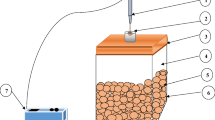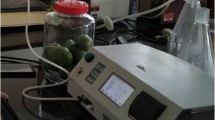Abstract
MAP is a dynamic system where respiration of the packaged product and gas permeation through the packaging film takes place simultaneously. The desired level of O2 and CO2 in a package is achieved by matching film permeation rates for O2 and CO2 with respiration rate of the packaged product. A mathematical model for MAP of fresh fruits applying enzyme kinetics based respiration equation coupled with the Arrhenious type model was developed. The model was solved numerically using MATLAB programme. The model was used to determine the time to reach to the equilibrium concentration inside the MA package and the level of O2 and CO2 concentration at equilibrium state. The developed model for prediction of equilibrium O2 and CO2 concentration was validated using experimental data for MA packaging of apple, guava and litchi.




Similar content being viewed by others
Abbreviations
- Ap :
-
Surface area of the packaging film, m2
- E :
-
Mean relative deviation modulus, %
- Ea :
-
Activation energy, kJ g−1 mol−1
- Eap :
-
Activation energy of gas transmission rates for O2 and CO2 (kJ/kg-mole)
- GTR:
-
Gas transmissions rates of films (cm3/m2 h ΔC) at temperature Tabs
- GTRp :
-
Gas transmission rates pre-exponential factor for O2 and CO2 (cm3/m2 h ΔC)
- K m(O2) :
-
Michaelis-Menten constant for O2 consumption, % O2
- K m(CO2) :
-
Michaelis-Menten constant for CO2 evolution, % O2
- K i (O2) :
-
Inhibition constants for O2 consumption, % CO2
- K i (CO2) :
-
Inhibition constants for CO2 evolution, % CO2
- RO2 :
-
Respiration rate, ml [O2] kg−1 h−1
- RCO2 :
-
Respiration rate, ml [CO2] kg−1 h−1
- YO2 :
-
O2 concentration inside the package (cm3 per cm3 of air)
- ZCO2 :
-
CO2 concentration inside the package (cm3 per cm3 of air)
- T:
-
Storage time in h
- Δt:
-
Time difference between two gas measurements
- Vf :
-
Free volume of the respiration chamber in ml
- W:
-
Weight of the fruit in kg
- R:
-
Universal gas constant, 8.314 kJ kg−1 mol−1 K−1
- R CO2 :
-
Respiration rate, ml [CO2] kg−1 h−1
- Rexp :
-
Experimental respiration rate, ml kg−1 h−1
- Rm :
-
Model parameter of enzyme kinetic
- Rpre :
-
Predicted respiration rate, ml kg−1 h−1
- R O2 :
-
Respiration rate, ml [O2] kg−1 h−1
- Rp :
-
Respiration pre-exponential factor
- T :
-
Storage temperature, °C
- Tabs :
-
Storage temperature, K
- t :
-
Storage time, h
- Δt :
-
Time difference between two gas measurements
- V f :
-
Free volume of the respiration chamber, ml
- V m (CO2) :
-
Maximum respiration rate for CO2 evolution, ml/kg-h
- V m (O2) :
-
Maximum respiration rate for O2 consumption, ml/kg-h
- YO2 a :
-
O2 concentration in the atmospheric air (cm3 per cm3 of air)
- ZCO2 a :
-
CO2 concentration in the atmospheric air (cm3 per cm3 of air)
- YO2 eq :
-
Equilibrium/optimum O2 concentration attained in the package
- ZCO2 eq :
-
Equilibrium/optimum CO2 concentration attained in the package
- Wp :
-
Weight of the fruits in MA package, kg
- Vfp :
-
Free volume in the package, cm3
- X:
-
Thickness of the film, cm
- OTR:
-
Oxygen transmission rates
- CTR:
-
Carbon dioxide transmission rates
- PO2 :
-
O2 permeability of packaging material (cm3. m−2 . h−1. [Conc. diff. of O2 in volume fraction]−1)
- PCO2 :
-
CO2 permeability of packaging material (cm3. m−2. h−1. [Conc. diff. of O2 in volume fraction]−1)
- dYO2/dt:
-
Rate of change of O2 concentration ‘YO2’ within the package at time ‘t’ of storage (cm3 per cm3 of air. h−1)
- dZCO2/dt:
-
Rate of change of CO2 concentration ‘ZCO2’ within the package at time ‘t’ of storage (cm3 per cm3 of air. h−1) respectively
- N:
-
Number of respiration data points
References
Cameron AC, Boylan-Pett W, Lee J (1989) Design of modified atmosphere packaging systems: modeling oxygen concentrations within sealed packages of tomato fruits. J Food Sci 54:1413–1421
Christie GBY, Macdiarmid JI, Schliephake K, Tomkins RB (1995) Determination of film requirements and respiratory behaviour of fresh produce in modified atmosphere packaging. Postharvest Biol Technol 6:41–54
Costa C, Lucera A, Conte A, Mastromatteo M, Speranza B, Antonacci A, Del Nobile MA (2011) Effects of passive and active modified atmosphere packaging conditions on ready-to-eat table grape. J Food Eng 102:115–121
Das H (2005) Food processing operations analysis. Asian Books Private Limited, New Delhi, p 406
Del Nobile ME, Licciardello F, Scrocco C, Muratore G, Zappa M (2007) Design of plastic packages for minimally processed fruits. J Food Eng 79:217–224
Exama A, Arul J, Lencki RW, Lee LZ, Toupin C (1993) Suitability of plastic films for modified atmosphere packaging of fruits and vegetables. J Food Sci 58:1365–1370
Geeson JD, Browne KM, Maddison K, Sheperd J, Guaraldi F (1985) Modified atmosphere packaging to extend the shelf life of tomatoes. J Food Sci Technol 20:336–341
Gonzalez-Buesa J, Ferrer-Mairal A, Oria R, Salvador ML (2009) A mathematical model for packaging with microperforated films of fresh-cut fruits and vegetables. J Food Eng. doi:10.1016/j.jfoodeng.2009.04.025
Jacxsens L, Frank D, Tom DR, Johan D (2000) Designing Equilibrium Modified Atmosphere Packages for Fresh-cut Vegetables Subjected to Changes in Temperature. LWT-Food Sci Technol 33:178–187
Kader AA, Zagory D, Kerbel EL (1989) Modified atmosphere packaging of fruits and vegetables. CRC Crit Rev Food Sci Nutr 28:1–30
Lee HS, Wicker L (1991) Anthocyanin pigments in the skin of lychee fruit. J Food Sci 56:466–468
Mahajan PV, Goswami TK (2001) Enzyme kinetics based modeling of respiration rate for apple. J Agric Eng Res 79:399–406
Mahajan PV, Oliveira FAR, Montanez JC, Frias J (2007) Development of user-friendly software for design of modified atmosphere packaging for fresh and fresh-cut produce. Innov Food Sci Emerg Technol 8:84–92
Makino YK, Iwasaki TH (1997) Application of transition state theory in model development for temperature dependence of fresh produce. J Agri Eng Res 67:43–52
Mangaraj S, Agrawal S, Gandhi AP (2005) Studies on physico-chemical changes in selected fruits during storage. Beverage and Food World 32(11):72–75
Mangaraj S, Goswami TK (2008) Respiration rate modelling of royal delicious apple at different temperature. Fresh produce 2(2):72–80
Mangaraj S, Goswami TK (2009a) Modified atmosphere packaging—An ideal food preservation technique. J Food Sci Technol 46(5):399–410
Mangaraj S, Goswami TK (2009b) Modified atmosphere packaging of fruits and vegetables for extending shelf-life-A review. Fresh produce 3(1):1–31
Mangaraj S, Goswami TK (2009c) Determination of maturity indices of fruits based on physico-chemical properties. Ind Food Pack 63(1):67–79
Mangaraj S, Goswami TK (2011a) Measurement and modelling of respirtion rates of guava (cv. Baruipur) for modfied atmosphere packaging. Int J Food Prop 14(3):609–628
Mangaraj S, Goswami TK (2011b) Modelling of respiration rates of litchi fruit under aerobic condition. Food Bioprocess Technol—Int J 4:272–281
Mangaraj S, Tripathi MK (2013) Sensory quality evaluation of MA packaged fruits applying Fuzzy logic. TrendsBiosci 6(2):195–199
Mangaraj S, Goswami TK, Mahajan PV (2009) Application of plastic films in modified atmosphere packaging of fruits and vegetables—A review. Food Eng Rev 1:133–158
Mangaraj S, Sadawat IJ, Prasad S (2011) Assessment of quality of pears stored under laminated modified atmosphere packages. Int J Food Prop 14(5):1–14
Mangaraj S, Goswami TK, Giri SK, Tripathi MK (2012a) Permselective MA packaging of litchi (cv. Shahi) for preserving quality and extension of shelf-life. Postharvest Biol Technol 71:1–12
Mangaraj S, Goswami TK, Giri SK, Joshy CG (2012b) Design and develoepeemnt of a modified atmosphere packaging system for guava (cv. Baruipur). J Food Sci Technol. doi:10.1007/s13197-012-0860-3
Mangaraj S, Goswami TK, Tripathi MK, Giri SK, Pajnoo RK (2013a) Neural Network modelling of respiration rates of litchi. Octa J Biosci-Int Peer-Rev Journal 1(1):32–43
Mangaraj S, Goswami TK, Giri SK, Chandra P, Pajnoo RK (2013b) Development and Evaluation of MA Packages Employing Lamination Technique for Royal Delicious Apple. Emirates J Food Agric 25(5):358–375
Peppelenbos HW, Leven J (1996) Evaluation of four types of inhibition for modelling the influence of carbon dioxide on oxygen consumption fruits and vegetables. Postharvest Biol Technol 7:27–40
Piskunov N (1981) Differential and Integral Calculus, vol 2. Mir Publishers, Moscow, pp 142–146
Rai DR, Paul S (2007) Transient state in-pack respiration rates of mushroom under modified atmosphere packaging based on enzyme kinetics. Biosyst Eng 98:319–326
Rocculi P, Del Nobile MA, Romani S, Baiano A, Dalla RM (2006) Use of a simple mathematical model to evaluate dipping and MAP effects on aerobic respiration of minimally processed apples. J Food Eng 76:334–340
Shivakumar D, Korsten L, Zeeman K (2007) Postharvest management on quality retention of litchi during storage. Fresh Produce 1:66–75
Singh SP, Pal RK (2008) Controlled atmosphere storage of guava (Psidium guajava L.) fruit. Postharvest Biol Technol 47:296–306
Song Y, Vorsa N, Yam KL (2002) Modeling respiration–transpiration in a modified atmosphere packaging system containing blueberry. J Food Eng 53:103–109
Tariq I, Rodrigues FAS, Mahajan PV, Kerry JP (2009) Mathematical modeling of the influence of temperature and gas composition on the respiration rate of shredded carrots. J Food Eng 91:325–332
Techavises N, Hikida Y (2008) Development of a mathematical model for simulating gas and water vapor exchanges in modified atmosphere packaging with macroscopic perforations. J Food Eng 85:94–104
Torrieri E, Cavella S, Masi P (2007) Modelling the respiration rate of fresh-cut Annurca apples to develop modified atmosphere packaging. Int J Food Sci Technol 46:1–10
Yam KL, Lee DS (1995) Design of MAP for fresh produce. In: Rooney ML (ed) Active Food Packaging. Blackie Academic and Professional, New Zealand, pp 55–105
Author information
Authors and Affiliations
Corresponding author
Rights and permissions
About this article
Cite this article
Mangaraj, S., K.Goswami, T. & Mahajan, P.V. Development and validation of a comprehensive model for map of fruits based on enzyme kinetics theory and arrhenius relation. J Food Sci Technol 52, 4286–4295 (2015). https://doi.org/10.1007/s13197-014-1364-0
Revised:
Accepted:
Published:
Issue Date:
DOI: https://doi.org/10.1007/s13197-014-1364-0




